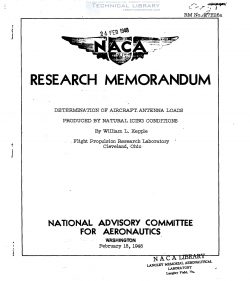naca-rm-e7h26a
- Version
- 55 Downloads
- 597.11 KB File Size
- 1 File Count
- April 21, 2017 Create Date
- April 21, 2017 Last Updated
National Advisory Committee for Aeronautics, Research Memorandum - Determination of Aircraft Antenna Loads Produced by Natural Icing Conditions

A flight investigation was made to determine the effect of
distance flown in the icing region, antenna length, and antenna
angle on the tension occurring in aircraft antennas while in
regions of aircraft icing.
The experimental antennas were of lengths ranging from 15 to
45 feet and. were placed at angles of 0° to 64° with the airplane
thrust axis. .Distances up to 256 miles were flown in diverse
icing conditions at true airspeeds from 15'? to 214 miles per hour
and Pressure altitudes at which icing conditions were encountered.
The results indicate that: The effect of ice formation on
antenna. tension increased. with the angle of the antennas with the
longitudinal axis of the airplane. The maximum: tension for
antennas having angles from 0° to 15° was 68 pounds, whereas the
meldinum tension for antennas having angles of 44° and 64° was
274 and. 458 pounds, respectively.
The current use of improved airplane ice-prevention equip-
ment has extended. operations in icing conditions and thus accen-
tuated the need. for protecting aircraft antennas against structural
failures resulting from ice secretions. A flight investigation
was therefore conducted at the NASA Cleveland laboratory to deter—
mine the tension in aircraft antennas produced by ice formations.
The investigation was conducted in natural icing conditions
over a range of true airSpeeds from 157 to 214 miles per hour and.
altitudes from 3500 to 9500 feet. Seven experimental antennas of
lengths ranging from 15 to 45 feet were placed at angles of 0° to
64° with the thrust axis of the airplane. The effect of the
following factors on the antenna tension was investigated: antenna
length, included angle between the antenna and the thrust axis of
the airplane, and distance flown in the icing region.
Multirotating cylinders, as shown in figure 4, were used to
determine the average droplet diameter, the drop-size distribution,
and. the liquid-water content. These cylinders were similar to
those used in reference 1 with minor mechanical modifications.
Pressure altitude and. indicated airspeed were measured by service
instruments and the ambient-air temperature was measured by a
shielded resistance-bulb thermometer.
| File | Action |
|---|---|
| naca-rm-e7h26a Determination of Aircraft Antenna Loads Produced by Natural Icing Conditions.pdf | Download |
Comment On This Post